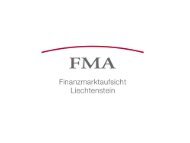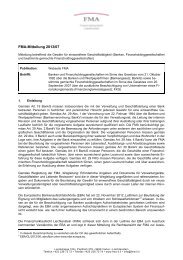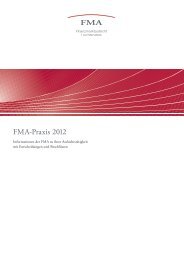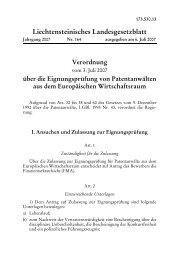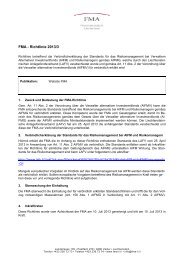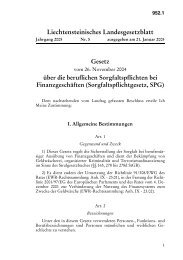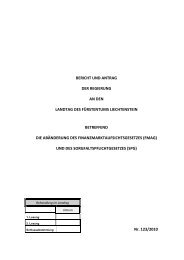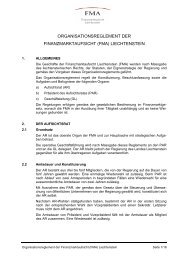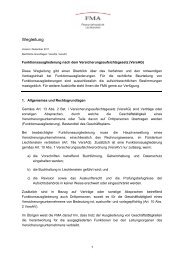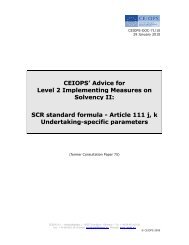CEIOPS' Advice for Level 2 Implementing ... - EIOPA - Europa
CEIOPS' Advice for Level 2 Implementing ... - EIOPA - Europa
CEIOPS' Advice for Level 2 Implementing ... - EIOPA - Europa
You also want an ePaper? Increase the reach of your titles
YUMPU automatically turns print PDFs into web optimized ePapers that Google loves.
3.6 It is noted that in the recitals to the <strong>Level</strong> 1 text, the importance of the<br />
principle of proportionality is explicitly linked to the need to avoid<br />
excessive strain on small and medium-sized undertakings. 7 This does<br />
however not mean that an application of the principle of proportionality<br />
is restricted to small and medium-sized undertakings, nor does it mean<br />
that size is the only relevant factor when the principle is considered.<br />
Instead, the individual risk profile should be the primary guide in<br />
assessing the need to apply the proportionality principle. 8 Hence where a<br />
(simplified) valuation technique is proportionate to the underlying risks<br />
and compatible with the Solvency II valuation techniques, it would be<br />
appropriate <strong>for</strong> application by the (re)insurance undertaking irrespective<br />
of its size.<br />
Estimation uncertainty and its link to proportionality<br />
3.7 Due to the uncertainty of future events, any “modelling” of future cash<br />
flows (implicitly or explicitly contained in the valuation methodology)<br />
flows will necessarily be imperfect, leading to a certain degree of<br />
inaccuracy and imprecision in the measurement. Sources <strong>for</strong> this<br />
estimation uncertainty or “model error” 9 are <strong>for</strong> example the possibility<br />
that the assumptions and parameters used in the model are incorrect, or<br />
that the model itself is deficient. 10<br />
3.8 Where simplified approaches are used to value technical provisions, this<br />
could potentially introduce additional uncertainty (or model error). This<br />
is the case since:<br />
• Often simplified method are used in situations where there is a lack of<br />
undertaking-specific claims data, in which case the setting of the<br />
parameters and assumptions used in the method will usually require a<br />
considerable amount of judgment; and<br />
• due to its simplicity the method may not be able to fully capture the<br />
nature, scale and complexity of the risks arising from the contracts.<br />
3.9 The degree of model error in the measurement of technical provisions is<br />
closely linked to the reliability and suitability of the valuation. Indeed,<br />
the higher the estimation uncertainty, the more difficult it will be <strong>for</strong> the<br />
(re)insurance undertaking to rely on the estimation and to verify that it<br />
is suitable to achieve the objective of deriving a market-consistent<br />
valuation according to the Solvency II principles.<br />
3.10 With regard to the principle of proportionality, these considerations show<br />
that it is important to assess the model error that results from the use of<br />
a given valuation technique.<br />
7 Cf. e.g. recital 14a of the <strong>Level</strong> 1 text.<br />
8 Compare paragraphs 11 and 15 in CEIOPS’ <strong>Advice</strong> on Proportionality<br />
9 In the following, the terms “estimation uncertainty” and “model error” are used synonymously. Hence the<br />
term “model error” is used in a broad sense, comprising the possibility that the assumptions and parameters<br />
used in the model are incorrect (in other sources, this latter risk is sometimes denoted as “parameter risk” as<br />
distinguished from model risk).<br />
10 In this context, uncertainty does not refer to the randomness of future outcomes (sometimes referred to as<br />
volatility risk or process risk), but to the fact that the nature of this randomness is itself unknown. The<br />
uncertainty of the risk in terms of volatility risk or process risk is an inherent quality of the risk (independent<br />
of the valuation method applied) and is assessed as part of the nature of the risk (cf. para. 3.38).<br />
9/112<br />
© CEIOPS 2010



